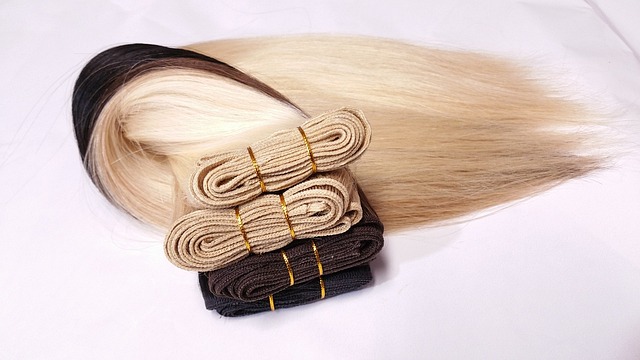A serene woman sits at her vanity, admiring her luxurious hair extensions, surrounded by beauty products.
Hair extensions vary greatly, lasting anywhere from 2 to 6 months, depending on the extension type and how well they are maintained. The durability of hair extensions is primarily influenced by factors such as the extension type, the quality of the hair used, and how they are applied.
Extensions made from human hair generally have a longer life than synthetic ones. Extensions like fusion and micro links tend to outlast semi-permanent options such as tape-ins and clip-ins.
Read more: Shopping Tips For Wigs For Black Women: What To Look For
Consistent care is critical to extending the life of your hair extensions.
Consulting a professional stylist is advisable to choose the right extensions that suit your hair and lifestyle. Hair extensions are an excellent investment to enhance your look with added length and volume. They give you the flexibility to explore new styles and colors. However, understanding their longevity before visiting the salon is crucial.
Different types of hair extensions are available, each with a unique lifespan. Knowing these can help you make a more informed choice and maximize your investment.
The Lifespan of Various Hair Extension Types
Various types of hair extensions come with different lifespans. The most common kinds include tape-ins, sew-ins, glue-ins, fusion, micro-links, and clip-ins.
Tape-ins generally last between 4 to 8 weeks before needing a touch-up. Sew-in and glue-in extensions also last about 6 to 8 weeks. Fusion and micro link extensions, on the other hand, can last up to 3 to 5 months. Clip-in extensions are not permanent and need to be removed after each use.
Importance of Hair Quality in Longevity
The quality of hair used in extensions basically impacts how long they last. Human hair extensions are preferred for their longevity and natural look. They can be styled, dyed, and handled much like your own hair, blending in flawlessly with genuine hair. Human hair extensions can last up to a year if properly cared for.
In contrast, synthetic hair extensions have a shorter lifespan, often only lasting about a month. These cannot be styled or treated with heat and are prone to tangling, further shortening their lifespan.
For a longer-lasting and more natural result, it’s recommended to choose human hair extensions.
Virgin vs. Remy Hair Extensions: What’s the Difference?
Two terms often come up regarding human hair extensions: virgin and Remy. Knowing the difference is critical when selecting the best extensions.
Virgin hair is completely unprocessed and maintains its natural color and texture. It lasts longer than most other extensions due to its high quality.
Remy hair refers to hair collected with cuticles intact, ensuring all hair strands run in the same direction. This prevents tangling and enhances its longevity. With proper care, Remy’s hair can last for several months.
How Application Methods Affect Durability
The method used to apply hair extensions also affects how long they last. Extensions fall into two categories: reusable and non-reusable.
Reusable extensions, such as tape-ins, sew-ins, micro-links, and clip-ins, can be reapplied multiple times, making them a more cost-effective option. When properly maintained, they can last several months.
Non-reusable extensions, like fusion bonds, attach more permanently and are more challenging to remove or reposition. These typically last a few months before needing replacement.
Maintenance: A Key Factor for Longevity
Proper maintenance of hair extensions is essential, regardless of whether they’re reusable or not. Reusable extensions should be handled carefully, following the salon’s recommendations, such as avoiding excessive heat and using gentle products. Regular salon visits are also necessary for repositioning and maintenance.
For non-reusable extensions, it’s crucial to avoid putting stress on the bonds and to use products that won’t weaken them. Regular check-ups with a hairstylist help extend their lifespan.
How to Care for Hair Extensions
To keep your hair extensions looking fresh and long-lasting, follow these care tips:
- Use sulfate-free shampoos and conditioners.
- Avoid excessive heat styling and always use heat protection.
- Gently detangle extensions with a wide-tooth comb or extension-friendly brush.
- Apply oils or serums to the ends to keep them hydrated.
Products to Avoid for Longer-Lasting Extensions
To increase the life of your extensions, you need to avoid the following products:
- Silicone-based products can weigh down and dull the extensions.
- Sulfate shampoos, which strip the natural oils.
- Alcohol-based styling products, as they dry out extensions.
- Oil-based products can make extensions greasy and heavy.
Steering clear of these products will keep your extensions in top condition.
When to Replace Hair Extensions
While each type of extension has a different lifespan, some signs indicate it’s time for a replacement:
- Excessive shedding or breakage.
- Noticeable damage like split ends.
- Matting or tangling that can’t be undone.
- There is a significant difference in texture or color between your extensions and natural hair.
- Hair growth that makes the extensions look unnatural.
If you spot any of these signs, it’s time to consult with your stylist for a new set.
Benefits of Professional Maintenance
Routine appointments with a stylist can help prolong the life of your extensions. Stylists can reapply, trim, and treat extensions to keep them looking fresh. This is particularly important if you use professional laser hair removal treatments alongside your beauty routine.
Caring for Specific Extension Types
Each type of extension requires a different care approach:
- Sew-in wefts: Avoid tugging at the braids and wash gently.
- Tape-ins: Use oil-free products near the tapes.
- I-Tips: Schedule maintenance for bead adjustments.
- Veila Pull-Thru: Handle gently to prevent damage.
Your extensions will last longer and stay in good condition by following specific care instructions.
Moving Up Extensions
“Moving up” involves repositioning extensions as your natural hair grows. This typically happens every 6-8 weeks. A stylist moves the extensions closer to the roots for a more natural look. Regular maintenance appointments are essential for keeping your extensions looking flawless.
Permanent Hair Extensions
Permanent hair extensions can last several months with the proper care. Avoid excessive heat and harsh chemicals to maintain their integrity.
Fusion bonds, laser med spa treatments, and V-light extensions are examples of permanent methods, each requiring different maintenance routines for optimal results. Fusion bonds, for instance, can last up to six months, while V-light and Combine extensions need more frequent adjustments.
By following these tips and maintaining a regular schedule with your stylist, you can ensure your hair extensions look great for as long as possible.

